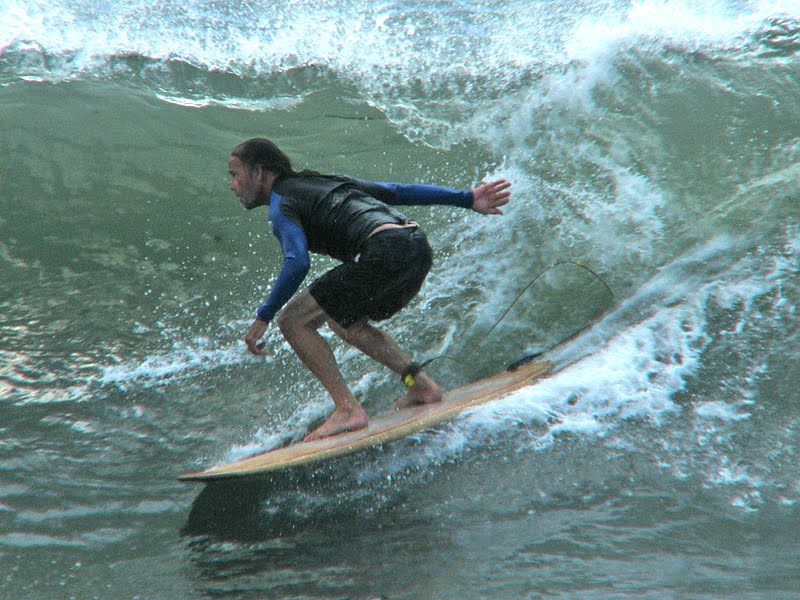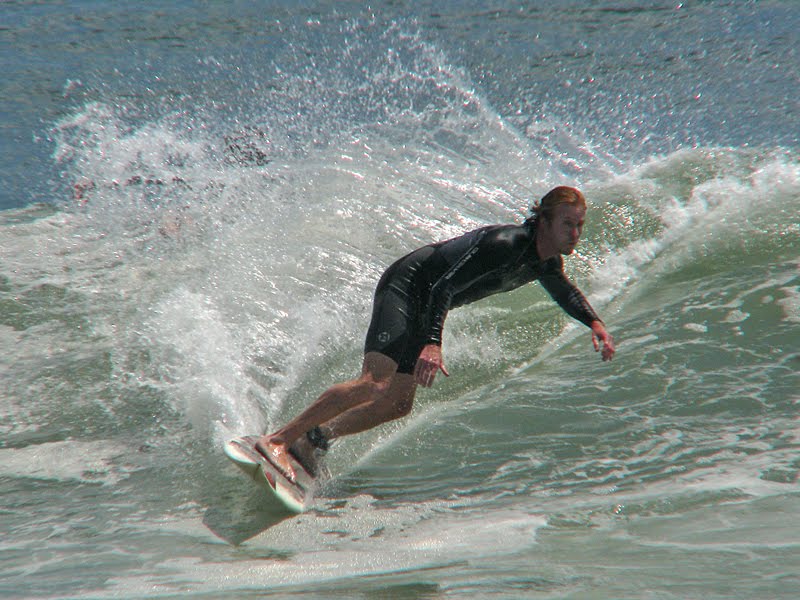
There's a romantic tale told in Newport about one of the town's early artisans; you hear it told on several of the historical walking tours and read it in several books about Newport, and on websites dedicated to African-American history in Newport. It goes like this:
Once there was an African named Zingo who became a slave belonging to famed Newport gravestone carver John Stevens II. Mr. Stevens, in the custom of the time, renamed his new servant Pompey and taught him to carve gravestones. Seven years after JS II's death Pompey was freed (in accordance with JS II's will) and retook his African name of Zingo. He became the premier carver of gravestones for the local African-American community and often incorporated African cultural elements in the ornaments and soul effigies on the stones he carved.
A very romantic tale, isn't it? Unfortunately, not a word of it is true. Evidence shows that Zingo and Pompey were actually two different men who were owned by two different Stevens brothers who had their own separate business establishments. And while there are actually two stones signed by Pompey Stevens, there is no evidence at all that Zingo was a carver, and the stones attributed to him were actually carved by John II's son John III. Yet despite the evidence (and we'll get to that in a little bit) most of the historical entities in Newport sell this romantic tale as actual history. Well, the tale itself is very tempting, isn't it? And oh so very politically correct!
In fact, I'll admit right now that for several years I was an ardent devotee of this tale. But there were some things that opened my eyes. The "bible" of colonial era gravestone carving in Newport is
Mallet & Chisel: Gravestone Carvers of Newport, Rhode Island, in the 18th Century, by Vincent F. Luti (2002). Chapter 11 - "The Case for a Black Stone Carver" (pp. 297 - 300) - goes into Luti's research and discoveries into the identities of both Zingo and Pompey Stevens. The other, further source of evidence, much of it based on Luti's work, is Caitlin GD Hopkins's website
Vast Public Indifference and her paper, posted online with Google Docs,
“This Stone Was Cut by Pompe Stevens”: Memorial Art and Public Memory in Newport, Rhode Island. The paper is here, the illustrations here (because Google Docs couldn't accomodate the photo files), and two other relevant blog posts are here and here. These are all well worth your time after you read my brief take on this particular subject. And if you're at all interested in New England gravestones and history, Caitlin's blog is well worth subscribing to!
The chief problem in this tale is the conflation of the two African men, Zingo and Pompey Stevens. In her blog post "Will the Real Pompey Stevens Please Stand Up?" Caitlin Hopkins says: The first problem — the conflation of Pompe Stevens with Zingo Stevens — may have begun as a simple misunderstanding. In her 1927 book, Gravestones of Early New England and the Men who Made Them, 1653-1800, Harriette Merrifield Forbes tentatively hypothesized that Zingo was owned by famed stonecarver John Stevens III and “perhaps . . . helped him in his work.” Though this speculation was both limited and reasonable, subsequent attributions have been less restrained.
It seems that from that one fairly vague and tentative statement things gained momentum and speculation was added to speculation until it became the current legend.
The problem is that Zingo Stevens's life is fairly well documented, and it doesn't intersect with a contemporary African servant named Pompey Stevens at all. First of all, Zingo was the slave of John Stevens II, not John III. And contrary to the legend (that his master renamed him Pompey and that he reclaimed his African name of Zingo
after his manumission seven years after John II's death), he was known, according to John II's last will and testament and the journals of local clergyman Ezra Stiles, as Zingo well before his manumission (a full inventory of documentary references to Zingo Stevens can be found in Luti, p. 299). Most important of all, though, is this from Luti (p. 299):
Finally, from Zingo's will of 1809 (recorded on 5 May 1817) we learn that he was a bricklayer. He left no tools in his estate inventory that suggest stone carving. Nothing whatsoever, then, even suggests that Zingo Stevens ever carved stones anymore than any other helper (there were many in Stevens's shop).
So much for Zingo Stevens as stone carver.
As for Pompey Stevens, there's not much of a record at all, except for the signed work he left behind. According to Luti and repeated by
Caitlin Hopkins:
We know much less about Pompe Stevens, but what is known does not fit Zingo’s life story. The first time Pompe’s name appears is on the gravestone of a one-year-old boy named Princ[e], the “Son of / Pompe Stevens / & Silva Gould,” who died on July 4, 1759. Six years later, a carver identifying himself as “P.S.” executed a gravestone for two-year-old Pompey Lyndon, and in 1768, he emblazoned his name on Cuffe Gibbs’ epitaph. (Note: The only other known Newport carver with the initials "P.S." was Phillip Stevens, who was murdered in 1736.) Though there is no record of Pompe Stevens after 1768, and he was probably dead or absent by 1783, the year in which Silva Gould married Cudjo Vernon.
If you compare the above dates with the dates given for the various events in Zingo Stevens's life on p. 299 of Vincent Luti's book, and especially when you consider that Pompey seems to have died somewhere between 1768 and 1783 while Zingo Stevens died in the first decade of the following century, there's quite a generational gap evident.
And what is evident from the carving he left behind is that Pompey Stevens worked for William Stevens, who had his own business on separate from the business founded by his father and carried on by his older brother and nephew. William had his own distinctive style, and Pompey's work is very much of that style.
Which brings us to a neat segue to the subject of artistic style in the stones in question. The photo at the top of the page is of the Cuffe Gibbs stone, about which there is no question as to the creator of the work as he names himself in the epitaph. The quality of the stone is poor and it's difficult to read; the same is true of the Pompey Lyndon stone, which Pompey Stevens also signed. To give you a clearer look, here are images of rubbings from the 1950s of both the
Cuffe Gibbs and the
Pompey Lyndon stones in the Farber Collection.
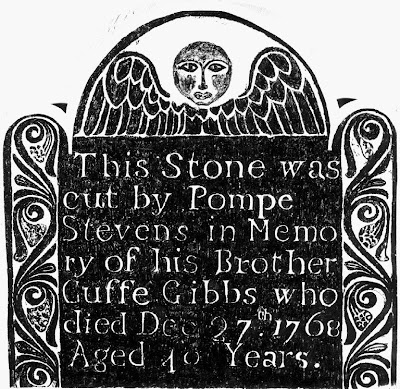

Compare these to these stones carved by William Stevens:


(Click on the pictures to see the full-size versions). The Peter Buliod stone (left) and the Nathan Townsend Jr. stone (right) are classic examples of William Stevens's work in the 1750s through the end of his career in 1775 (he moved to Philadelphia in that year and nothing more is heard from him after that). And Pompey Stevens's work is most definitely the work of a pupil following his teacher - the head shapes and wing designs in the soul effigies and the fig-and-lily pattern borders. The lettering is different, but then that's usually the unique distinguishing characteristic of individual carvers working in the same shop.
What especially distinguishes Pompey Stevens, though, is the uncharacteristic naming of himself in the epitaph on his brother Cuffe's stone. This was a bold stroke, especially on the part of an African-American slave in colonial times. As Caitlin Hopkins says in
her paper:
Other gravestone carvers signed their work, but Pompe Stevens’ integration of his own authorial statement into the text of the epitaph, rather than relegating it to an inconspicuous corner, is practically unheard of in the New England stonecarving tradition. By emblazoning his own name across an enduring, public memorial, Pompe Stevens created a monument to his own life, as well as to his brother’s.
The last task in this post (yes, I'm almost done; you can return to your regularly scheduled program in just a bit) is to address the artistic ownership of the stones most often pointed to in the Zingo/Pompey mythos as carved by him. What emerges from a study of this is that the stones attributed to Zingo Stevens were actually carved by John Stevens III, the son of Zingo's former master. John III's work is unique and exquisitely beautiful. Both he and contemporary Newport carver John Bull were, in my own not-so-humble opinion, the most artistic carvers in America at the time. They didn't just carve gravestones, they created art.
The stone most pointed to as the work of Zingo Stevens is the gravestone of his wife, Phillis Lyndon. The stone has deteriorated dramatically over the years; this is the best I could do with the soul effigy in the tympanum:

And now compare that to these stones signed by John III:


(Again, click on the images to see in greater detail.) The three-quarter profile, clouds in the sky, and especially the African features - broad, flat nose and curly hair - are all similar, and are a mark of the stones carved by John III for the African American community. There are also other designs on these, like jewelry, clothing, and markings on the tympanum borders, which suggest West African cultural survival, which have led some writers (including yours truly several years ago, before I learned better) to point to these as works by Zingo Stevens, even though the Dinah Wigneron (left) and Pompey Brenton (right) stones are signed by John III; I even had a tour guide point out Pompey Brenton's stone as carved by Zingo Stevens until I showed her the "Cut by J. Stevens Jnr" carved into the base. In any case, Caitlin Hopkins addresses just this point in
her paper:
What, then, of the gravestones from the 1770s and 1780s that do seem to exhibit African survivals? All can be positively or stylistically attributed to John Stevens III, a talented young carver whose flair for portraiture is evident in the stones he carved for both white and black Newporters. Every detail of the stones dedicated to Pompey Brenton, Dinah Wigneron, Violet Hammond, and others with purported African cultural elements conforms to the style of stones signed by John Stevens III (figures 11-13). Unlike Pompe Stevens’ signed work, which boasts deep, plastic carving and haphazard word spacing, John Stevens III embraced an airy aesthetic with meticulously spaced lettering and neo-classical aspirations. His use of fine-grained blue slate, his light incisions, and his fondness for the three-quarter profile are all features of the supposedly African-influenced stones (figure 14). As of this writing, no scholar has attempted an investigation of John Stevens III’s relationship with his African-American clients, but the extraordinary objects he produced suggest a level of intimacy and collaboration not evident in the older slaveowner-commissioned gravestones.
There's no question that John III carved these stones; the question is where he got his inspiration.
So what's the point of bringing all this up, anyway? What does it matter? For
Caitlin Hopkins, the point is clear: "...by focusing their attention on Zingo and the misattributed stones, they overlook the very real, identifiable, and important work of Pompe Stevens." To that I say Amen! But I have a further concern: intellectual integrity and the importance of critical thinking. the ability to examine evidence free of preconceived notions and prevailing contemporary "wisdom". To hold to a myth in the face of evidence is troubling; to do so in order to make the myth fit a prevailing cultural/political agenda strikes at the very heart of personal integrity.Look, I'm a total sap, a romantic from way back. I tear up at
Les Miserables and Ursula K. LeGuin's
Malafrena and
The Dispossessed; I dream of manning the barricades when the Revolution comes. What the heck, I believed the Zingo Stevens tale when I first came across it because it fit all my romantic visions. But I can't hold onto a myth if honest, clear evidence proves otherwise. No historian should be able to do that and still call him or herself a historian; the individual's intellectual honesty and integrity is called into question if that's the case.
And there you have it. I hope I haven't bored you too terribly. I just had to get that up and posted because it's been weighing on me ever since the last historical tour I took where the myth was propounded. You can all go back to your dinners now.
© 2010 by A, Roy Hilbinger





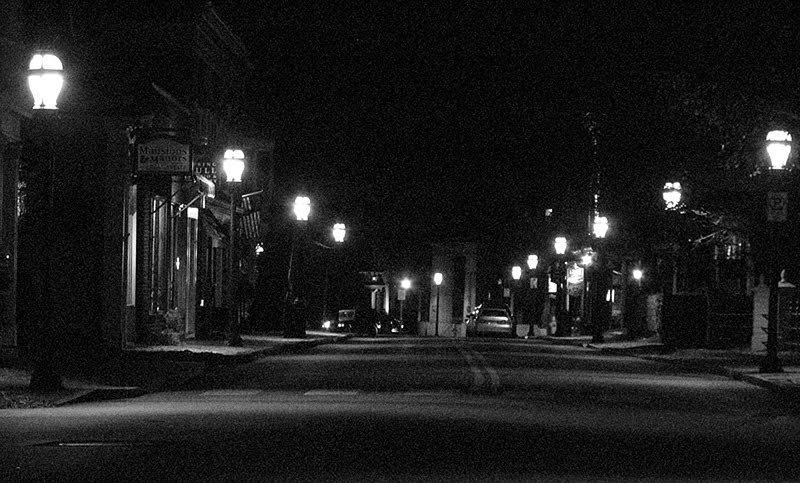

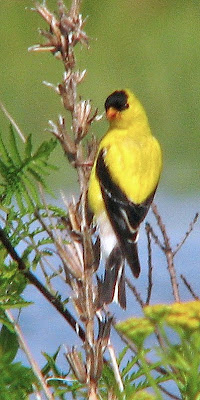



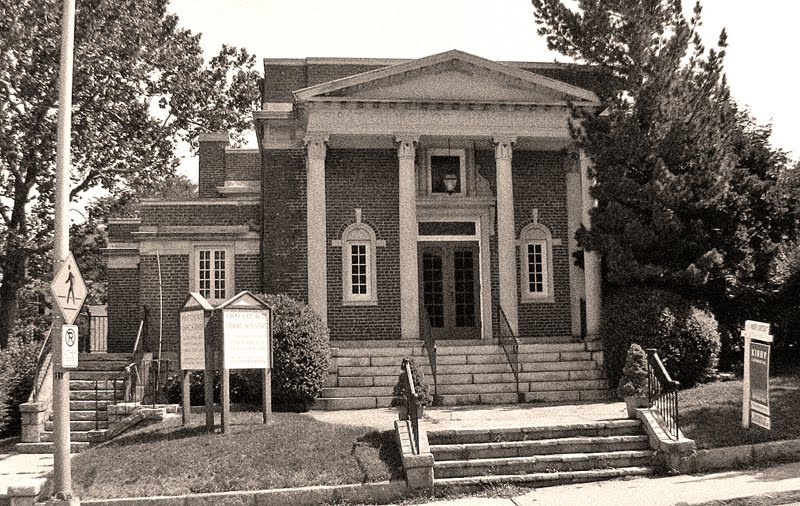



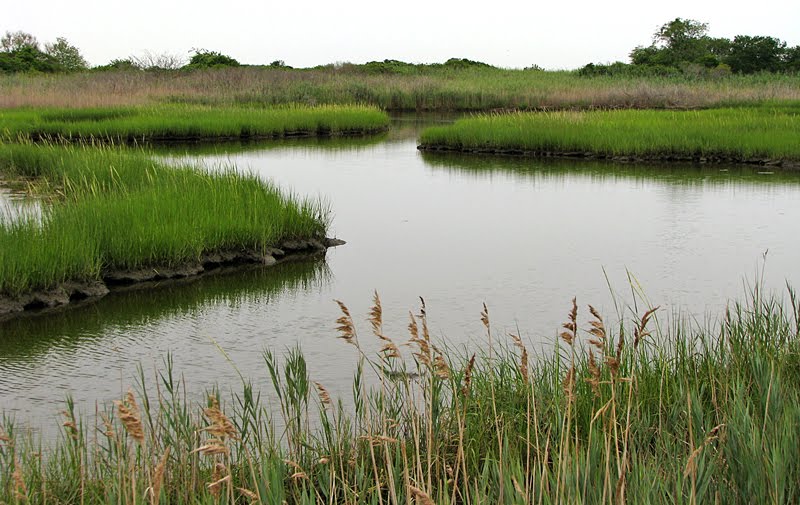



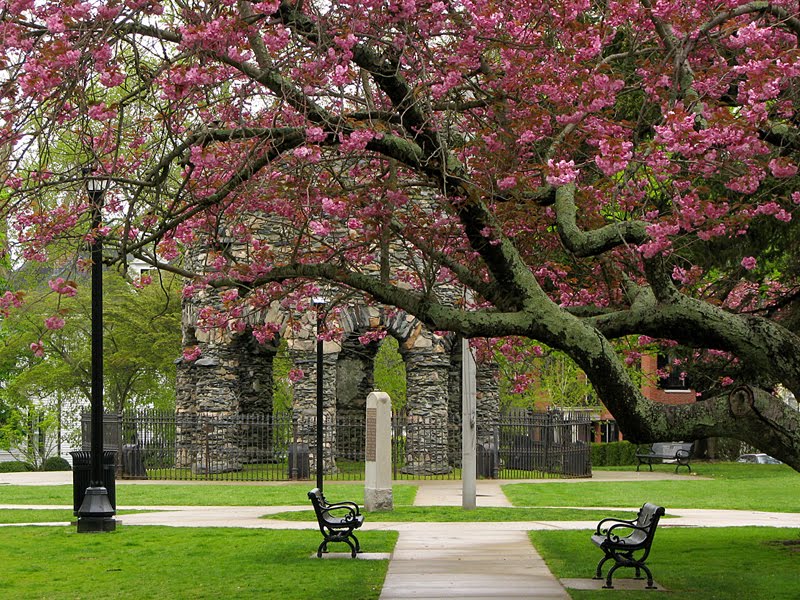
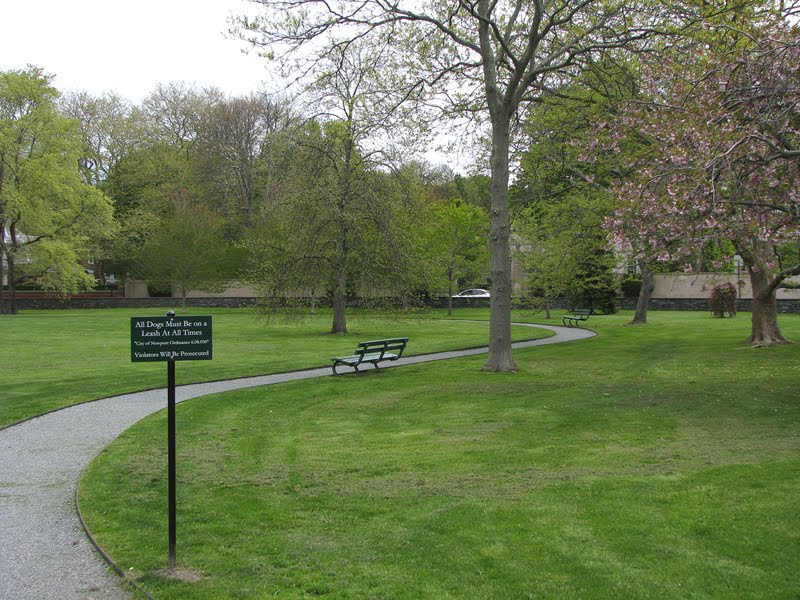
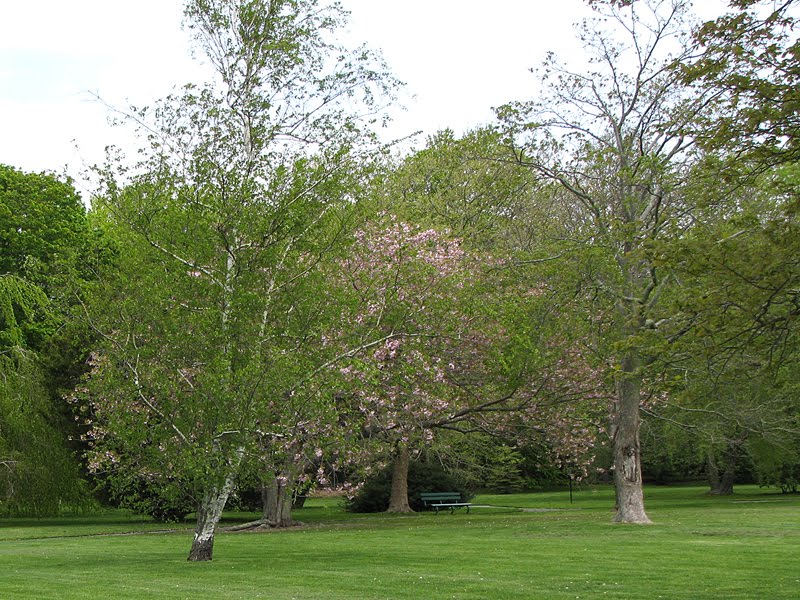










 There's a romantic tale told in Newport about one of the town's early artisans; you hear it told on several of the historical walking tours and read it in several books about Newport, and on websites dedicated to African-American history in Newport. It goes like this:
There's a romantic tale told in Newport about one of the town's early artisans; you hear it told on several of the historical walking tours and read it in several books about Newport, and on websites dedicated to African-American history in Newport. It goes like this:









